Thursday, April 27, 2017
Wednesday, April 26, 2017
What I’ve Learned From Recording 300 Podcast Episodes
When I started this podcast on January 18th, 2011, I had no idea what 100 episodes would look like.
And now I’m 300 episodes in. It has been an interesting journey.
Listen to This Episode
Inside this episode, I share ten lessons I learned through the process of recording 300 episodes.
Side note: I’m intentionally leaving out a lot of the details from this written post because I think you should listen to the episode to get the most value from this one.
Lesson 1: It’s important to get started.

Just get started with it!
When I started this podcast, I didn’t even have a name. I had not figured everything out. But I got started.
My show wasn’t perfect, but it was my show. And just the act of getting started put me in a position to learn so much.
And by doing so, I got better. If you’ve been thinking about starting something, just do it!
Lesson 2: There’s value in helping others.
This one seems very obvious, but it’s so basic that I think a lot of people miss it. When you create content that helps others, you’re doing something valuable.
You can build a business around that.
Lesson 3: You get better over time.

You get better over time.
We’ve all heard the saying that “Practice makes perfect”.
Well, it’s true. In the episode, I share clips of my first interview for you to hear how BAD it was.
But I kept doing it, and I got better.
Lesson 4: Consistency is key!

Consistency is key.
If you’re creating content, it’s important to be consistent. You want people to be able to put you into their schedules.
Whenever I stop posting episodes for a little while, my listens go down.
Lesson 5: Don’t be afraid to reach out to “big” names.
On the day I recorded this episode, I got an email from someone asking this question: “How did you manage to interview famous People?”
My answer was simple – ASK.
You’d be surprised at who would say yes. I remember reaching out to Guy Kawasaki and getting a Yes within an hour.
My mind was blown. So don’t be afraid. Reach out. The worse that can happen is that you hear no, and then you’re exactly where you were before.
Lesson 6: Connect with people in a real way.

Connect with people the real way.
It always amazes me when I attend an event and someone comes up to me because they recognized my voice from my podcast.
After connecting in person, it becomes audience that there was a connection that happened before that in-person meeting.
That comes with simply being “real” in your podcast. Don’t try to be someone else. Be yourself.
Lesson 7: It’s ok to make mistakes.

Making mistakes is okay.
I don’t edit my podcast episodes. Why? Because I don’t feel the need to. Do I make mistakes? Absolutely.
But doesn’t everyone else?
Making mistakes make you appear normal (real). People identify with real people.
Lesson 8: Ignore the haters.

Ignore the haters.
Ok, there’s good news and bad news. The bad news is that you’re going to have haters.
The good news is that it doesn’t matter.
Ignore them and focus on serving the people who actually care about your stuff.
Lesson 9: If you have a vision for helping people and do it consistently, you WILL have an impact.

You will have an impact if you help people consistently.
Why do you do what you do? What’s your underlying reason?
As bloggers, it’s important for us to acknowledge that “why” and then use it as a driving force to help us move forward.
If we focus on that and continue pushing ahead, you will have an impact.
Lesson 10: Don’t get too caught up in the numbers.

Don't get caught up in the numbers.
My download numbers don’t compare to MANY of my friends. And that’s ok.
Because when I actually meet the people who listen to my podcast, they aren’t just numbers. They are people.
People whose lives are impacted because of the content I create.
If you have 50 or 100 people that listen to you, that’s 50 to 100 PEOPLE.
Summary
Starting this podcast was one of the best decisions I’ve ever made. I’m 300 in, and looking forward to the first 1,000.
THANK YOU!
Thanks for listening. Thanks for joining me on this journey. Thanks for taking me on the journey with you.
I would not be here without you, so THANK YOU!
Infographic

10 Lessons I’ve Learned From Recording 300 Podcast Episodes

Ignore the haters.
The post What I’ve Learned From Recording 300 Podcast Episodes appeared first on Become A Blogger by Leslie Samuel.
from
http://www.becomeablogger.com/25027/what-i-learned-300/
Thursday, April 20, 2017
How to Make People Like You In 5 Seconds Or Less… (No Gimmicks. No Tricks. Just 3 Quick Tips).
There’s one thing I do that makes people like me.
I never realized I did it.
I just did it.
I don’t want people to think I do this to be manipulative.
FAR FROM IT.
I just noticed that I often did it in social situations and it works like a charm. Especially if you’re meeting someone new.
I’m Derek Halpern, and I’m the founder of Social Triggers. A top destination for entrepreneurs who want to get ahead in business and life.
When I was in college, I wasn’t the best at talking to people.
Who am I kidding?
I was straight up bad at it.
I didn’t have confidence in myself, and I never knew how to interact with people. I’d kind of always be the quiet “wallflower” who observed… but never said anything.
Some people thought I was stand-offish… probably because I was standing off… to the side… Other people just didn’t find me interesting enough to hang out with.
This isn’t some pity party though.
If you fast forward to today, you’ll find that I know how to enter any room, talk to anyone, and most important: ensure everyone is having a great time. Don’t take my word for it though.
Here’s what Steve Kamb from Nerd Fitness said when he saw me do it:
“Derek is a friend of mine, and I’ve witnessed him take over a room in New York City within five minutes simply through his actions, mannerisms, and voice; it was hilarious and inspiring.”
Or, as another example… I got this text message from a friend:
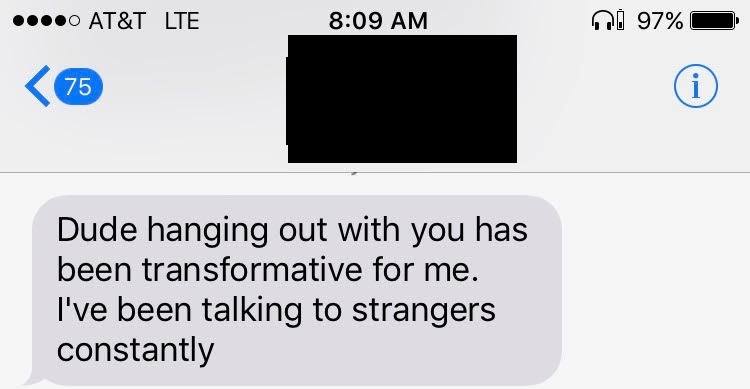
Or how about this message from a friend just the other day:

How do I do it?
Over the last 15 years, I practiced. A lot.
I’d practice in weird ways, too.
Here are a few examples…
Example #1: How I Introduce Myself To Almost Anyone
I went to the local mall and I had a simple rule for myself: talk to every single person I saw. Even if I just said “hello.” And let me tell you, it felt weird. Especially for me. I was introverted and I didn’t like talking to strangers. But I did it.
At first I started off with a meek hello, and I remember people would look at me weird. Then over time I kind of made it a game. I’d try loud hellos. I’d try low hellos. I’d try smiling then saying hello. I’d try saying “what’s up.” I literally tried everything.
Eventually I figured out that the best way to say “Hello” to someone you don’t know, for me, was a combination of, “Hey? What’s up…”
I purposely would intonate the Hey so it sounded like a question, and lead with “What’s up.” People would always get a little confused – as opposed to defensive – and say, “Wait. Do I know you?” Or they’d just say “Hello” back.
At that point, I’d always say, “No, you don’t know me.”
Then I would comment on something that was nearby like:
“I saw you looking at…”
Or I would make a comment about myself, like:
“I’m new here, and I’m looking to meet people…”
Over time I got real good at this. Now I can walk up to anyone and talk to them as if we’ve been friends forever.
Example #2: How I Conquered Social Awkwardness (The trick? NUMB THE PAIN!)
As I began practicing things like Hello, the first thing I noticed was this: the more I did it, the less awkward it got. Setting a rule like “say hello” to everyone acted like a numbing agent. The more I did it, the less weird it felt.
So I thought, “I NEED MORE RULES!”
Meaning…
I needed to keep talking to new people, and I needed to take every chance I got to do it.
So, the next thing I did was this…
I decided to talk to EVERYONE who was essentially paid to talk to me.
I’ll explain.
When you buy a coffee at the coffee shop, the people who work there are paid to talk to you. They aren’t your therapist, of course. But you do have an opportunity to talk to them.
Let me give you an example. Most interactions between customer and coffee shop barista go something like this:
Customer: “Hey, I’d like a large coffee.”
Worker: “Anything else?”
Customer: “No. Thank you.”
And they probably get this one million times a day.
BORING
So, I’d just change it up.
Me: “Hey! I’ll have a large coffee. And I like your shirt.”
Worker: “Oh thanks! Anything else?”
Me: “No, that’s it.”
Simple.
Place your order, and add a quick compliment into the mix. It’s easy. And if you do it enough, you’ll start to feel more comfortable saying even crazier things.
Here’s an example:
Me: “Hey, I’ll have a large coffee.”
Worker: “Oh, thanks, anything else?”
Me: “Wait a second. ITS DISCOUNT TUESDAYS?”
And I’d say it real loud as if i was joking.
They’d laugh. I’d pay, and then tip.
Or another example…
Me: “Hey, I’ll have a large coffee.”
Worker: “Thanks. That will be $5.50.”
Me: “FIVE FIFTY? FOR COFFEE? THIS IS NYC! I thought it would be at least 6.50.”
Now as you might imagine…
Sometimes something I’d say would land perfectly. And I’d put it in the mental bank to do it again. Sometimes it would fall flat and I’d either change up the way I delivered the comment… or never use it again.
It was like a “natural” experiment. But the most important thing? The more I did it, the more I got used to doing it.
And the more I got used to doing it, better at it I became.
Example #3: You Can Literally Say ANYTHING (if delivered right)
While working at becoming better at talking to people, I began to notice that you could literally say anything to anyone… if delivered right.
And I mean anything.
Remember the text message I showed you earlier?
This one:

One of the things I told him to do was this: you can literally say anything to anyone… as long as you’re not mean spirited or offensive… and you can start a conversation.
Here’s a real life example…
I had just walked into a restaurant, and the only seating available was at the bar. And it’s first come, first served.
The problem?
There are no seats.
So I spot two women sitting next to one another. They’re both enjoying a drink. I walk up to them both, and say this:
Me: “Hey, Can I please have your seat because I’ve been standing up for about 17 seconds right now… and I don’t want to stand anymore.”
Her: “Sure…”
And she gets up.
I sit in the seat, and lean over to the other friend.
Me: “Wow. Some friend. SHE JUST DITCHED YOU!”
Everyone laughed.
I tried to give her her seat back, but she wouldn’t take it. And we all ended up joking and having a good time. All because I went up to someone and asked them to give me their seat as the first comment.
Why did this work so well?
Some people may think it’s because I said “because.” Robert Cialdini wrote about the power of because in his book Influence. And sure, that’s part of it.
But I actually employed a specific technique that I learned through years of practice.
I call it Sincere Compliment Then Ridiculous Insult Technique
Here’s how it works:
Let’s say you walk into a busy coffee shop. It’s slammed. You noticed someone working behind the counter, and you want to leave a positive impression.
Me: “Whoa! Place is slammed, and you’re doing well. But uh can you please grow a third hand and hurry up?”
Now of course you can’t continue on a conversation like this. They’re WORKING. But these “little” interactions can help you set a solid foundation with someone to start a future conversation.
Maybe you’ll bump into them on their way out of work. Or into work. But this sort of exchange is often memorable. So the next time you two talk it will be easier to start the conversation.
Let me share a different example.
Let’s say you’re sitting at a bar. You see someone next to you and you want to strike up a conversation. You notice they’re wearing a statement piece, maybe like an oversized watch. And you notice it on their left hand.
At this point, if you’re also wearing a watch, I’d move the watch to your right hand. And this is what I’d say…
Me: “Hey. Love your watch. But is there something wrong with you?”
Her: “What do you mean?”
Me: “Well, look at mine. It’s on my right hand. I always thought people who wear watches on their left hand are weird.”
Now I know these may seem cheesy.
And they are.
But go back to the seat example…
What did I do? I was brazen enough to ask for her seat. And then I immediately levied a ridiculous insult… “She just ditched you!”
Opening a conversation with a stranger is tough.
Everyone has their guard up. And that’s why this technique works so well. It almost guarantees a little laugh. And even if it’s only a small laugh, the genuine laugh makes people like you enough to at least continue talking with you.
And that’s the key.
You aren’t going to win hearts and minds for life with this technique. But you can open a conversation with a stranger and make them like you enough to at least keep talking to you for a little bit. And let me tell you, that’s HALF THE BATTLE.
How does this change in a more traditional business networking event?
It doesn’t change one bit.
Here’s an example:
Him: “I’ve been working on my new product for the last 3 months, so I had to stop going to conferences.”
Me: “Wow. Nice job on the product, but you mean to tell me that you can’t just clone yourself and work on your product AND go to conferences?”
It’s simple.
It guarantees a small laugh.
And it’s a simple way to make someone like you in 5 seconds or less.
But I must reiterate…
This isn’t how win people over for life. This is just a simple conversational technique that can help you stand out.
Now how do you come up with a “Ridiculous Insult?”
Well, that’s the tough part, but it has to be something that’s light-hearted and won’t offend anyone.
Look at the coffee shop example. They’re busy. Telling them to hurry up is rude and obnoxious. Telling them to grow a third hand – RIDICULOUS – and hurry up is just silly.
Or, let’s look at another example.
Me: “Hey, I like your hair. I used to have hair like that. But random people kept pulling it. Do you have that problem?”
Her: “No…”
Me: “Oh, my hair must have looked nicer.”
Again.
A sincere compliment. A ridiculous insult.
Or another example.
Me: “Damn dude. You’re getting strong.”
Him: “Thanks man.”
Me: “Now only if I liked you as a person…”
A sincere compliment. A ridiculous insult.
The key here really is this…
You say something that would USUALLY be insulting, but you make it so ridiculous that it’s not. It’s just funny.
So….
When you want to make a friend.. land a date… meet some new… you need to make people like you enough to continue talking to you.
Then, what you say next is up to you.
This technique is enough to get people to like you in 5 seconds… but it won’t be enough to make them like you for 15 minutes.
So, let’s recap…
The truth about making people like you is this:
It’s not a skill you’re born with. It’s something you learn over time. Even the people who are best at dealing with people don’t come out of the womb being good at it. They just likely practiced more as a child than you did.
And with practice, you CAN get better at it.
I’ve wanted to talk about this sort of stuff for YEARS.
But I have resisted.
I partly thought I wouldn’t be good at teaching it online. I thought I had to do it in person. But then I started testing some of my “teaching” here and there…
…and people have been getting some great results.
One friend would regularly harass me too. He’d send me messages like this:

And he’d ask for a course on social skills, like clockwork, every few weeks.
However, that’s about to change.
As you can see.
:-).
For now, here’s what I want you to do…
Take one of these examples from this article today… AND TRY IT OUT!
Then let me know what happens.
Or, more specifically…
Just say “Hello” to 5 people today and let me know how it goes. Even if it’s something who’s paid to talk to you. Do me a favor though…
When you do it, leave a comment, I’d love to hear two things: “How I thought it would feel.” And “How it actually felt.”
Also…
If you’d like to learn more about how to become better at dealing with people, I’d really appreciate if you can fill out this quick survey.
It’s going to be a fun one ;-).
from
http://feeds.socialtriggers.com/~r/SocialTriggers/~3/b3Htt6HOqQ0/
Wednesday, April 19, 2017
How to Repurpose Your Content to Drive Traffic
Are you struggling to drive traffic to your blog?
When you create a blog post, do you move on to the next one?
If so, you are missing out on a lot of traffic.
Listen to This Episode
By the end of this post, you'll have a step-by-step plan for repurposing your content.
The result – more traffic to your blog. Ready? Let's go.
What is Content Repurposing
Content repurposing is taking one piece of content and recycling it.
Once recycled, you can use it for a different purpose.
Why Repurpose your Content
Content marketing is one of the most effective strategies for driving traffic.
People visit websites and blogs for the content. They may have a specific problem they are trying to solve. They may be looking for entertainment.

Repurposing Content to Increase Traffic
One of the great things about being a blogger today is that there are so many social platforms to choose from.
Your audience has options for where they want to consume content.
But here's the thing – your entire audience won't be on one social platform.
No, they have varying preferences. And if your content is not in the location where they spend their time, they are less likely to see it.
Here's the thing – when you create a unique piece of content, you've done the most difficult part.
You took an idea and turned it into something tangible.
Repurposing the content is much easier because you don't have to come up with an original idea.
By having a clear repurposing strategy, you can post your content in many places.
The result – more people find your content and come back to your blog.
That's why repurposing content is so powerful.
A Strategic Plan for Repurposing Content
Most people don't repurpose their content because it seems like a lot of work.
And yes – it can be a whole lot of work.
I wanted to make it easier for you. So I decided to come up with a plan that simplifies the process.
Here we go…
Step 1: Create a content roadmap
To maximize your success with repurposing content, let's start with a big plan.
Instead of looking at each blog post as a single unit, let's look at them as parts of a whole.

Create a content roadmap
Your ultimate goal is to create an entire product, like an ebook, course, webinar, etc.
What topics do you need to cover and in what sequence? Those individual topics will be your blog posts.
When you get through that sequence of blog posts, you will have the makings of a new product.
And yes, you can then repurpose it as a free giveaway, or even a product for sale.
It's a beautiful thing.
Step 2: Start each individual post with an outline

Start each individual post with an outline
Have you ever read an entire blog post only to figure out that it didn't make sense?
I have, and it sucks.
Don't be that content creator. Start with an outline.
Doing so will help you solidify your thoughts and make sure it has a logical flow.
Every piece of content I create starts with an outline, and that makes me way more efficient.
Step 3: Create a video

Create a video
I know, you didn't expect that. I recommend starting with a video because it's easy to get many forms of content from a video.
Here's the key – if you start with a video, you can have other people do the rest of the work.
Now, everyone won't be comfortable doing video. And if that's you, it's ok. You can skip to step seven. There's still a lot you can repurpose with written content.
Or if you're approaching this from the perspective of a podcaster, skip to step 4.
Step 4: Create a podcast episode
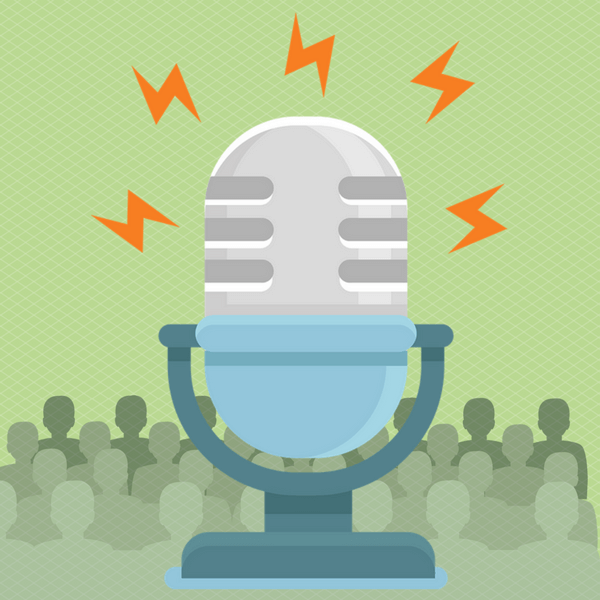
Create a podcast episode
If you started with a video, export the audio and create an MP3 file. You can use this as a podcast episode that gets submitted to iTunes and other directories.
Or you can add it to your blog post without creating an official podcast feed.
If you aren't doing video but are a podcaster, you will use this content to move on to the next step.
Step 5: Get that video/audio transcribed
Some people still like to read. Whether you're a video creator or podcaster, having a text alternative is a good idea.
Here are two great services that offer transcription at a great price:
- Trint: This service offers computer-generated transcripts. They are better than any other technology I've used for transcripts in the past. And you can go in and edit the errors. It starts at $12/hour of audio/video.
- Rev: This service uses real people to transcribe your content at a cost of $1/minute of audio/video.
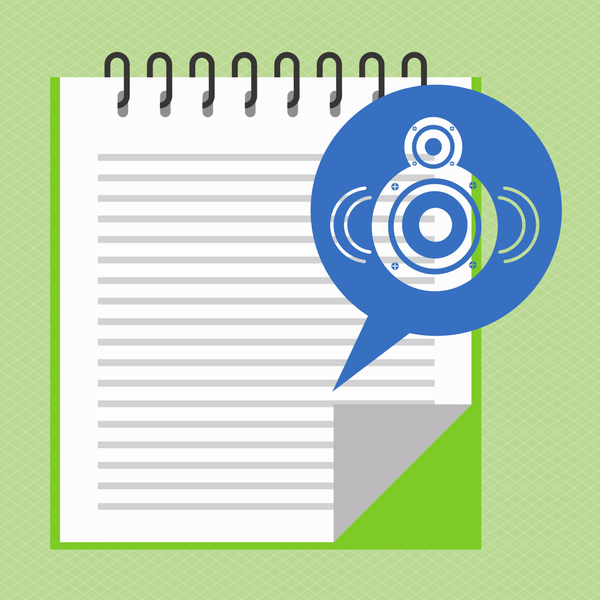
Transcribe your video/audio and have the transcript formatted.
These services both end up being VERY cost-effective if you're doing short videos.
Step 6: Format the transcript
Now that you have a completed transcript, format it to make it look good. You can add this to your post for download or as a lead magnet.
Step 7: Write an article
Once your video/audio is ready, you can write (or have someone else write) an article based on the content.
If you opted not to go with video or audio, use your outline to write and article.
Here's the thing – Google does a better job at indexing text than any other form of content.
Make Google happy, as well as your audience who likes to read.
Step 8: Pull out content snippets
Now that you have a well-written article, it's easy to rip it apart into content snippets.
Here's how I recommend you do this:
- Set a timer for 10 minutes
- Pull out 5 – 10 quotes and excerpts
- Come up with 5 – 10 tweets
- Write 2 or 3 status updates
Since the content is fresh on your mind, it'll be easy to pull those content snippets out.
And feel free to pull out more than I suggested.
Step 9: Create image quotes

Create image quotes
You already have quotes from the previous steps. Now use a service like Adobe Spark or Canva to create image quotes.
It's a good idea to have a few image quote templates pre-designed to make this process easier.
You can then use these image quotes on social media to promote your content.
Step 10: Create a slide deck
I learned about a neat trick from Ana Hoffman from Traffic Generation Cafe.
Did you know that you could import an outline into PowerPoint and it will create slides for you automatically?
I didn't, but it's easy. Here's how you do it.
Save your outline as a .txt file. You can do this with almost any Word Processor.
In PowerPoint, go to “Import > Slides from > Outline”.
Voila. You now have slides.
And now you can go through and format those slides and make them look pretty.
Now you have a slide deck that you can upload to Slideshare. And by having links in your slide, you can direct people to your post (or giveaway page).
Step 11: Create video from slides

Create video from slides
If you didn't start with a video, you can still redeem yourself here. Connect a mic to your computer and use Screenflow or Camtasia to record your screen as you talk through your PowerPoint.
Now you have a video that you can upload to YouTube and/or Facebook.
Of course, you'll also be linking back to your blog.
Step 12: Create images from your slides
Guess what? You already did the work of creating an awesome slide deck. You can use that to create a bunch of images.
Go to “File > Export” and then select the JPG file format.
Now you have images that you can use throughout your post and on social media.
Step 13: Create an infographic

Create an infographic
Take that outline (once again) and use that content to create an infographic.
You can use a service like Canva to do that.
Step 14: Create your final product
Do you remember how we started? With a roadmap for creating a product.
Well, once you've gotten through the posts in your roadmap, put them together into a product.
You can use it to create a webinar, ebook, course, or any other resource.
You can then use that product as a lead magnet or put it up for sale.
Let's make this very practical
It's possible that you went through all that and thought – WOW, that's a whole lot of work.
Well . . . yes, it is.
But here's the thing – you don't have to do it all.
If you look through this post you will notice that I do include a few elements but not all.

Choose ONE format to add to your current workflow
I have:
- The written article
- Podcast episode
- Slide deck
- Infographic
- Tweets and status updates (in a Google doc behind-the-scenes)
- We also create image quotes when I do interviews
It's NOT about making sure you create all. Here's what I recommend.
Choose ONE format to add to your current workflow. Start working on that format for your future blog posts.
Refine the process by deciding who will do it, when and how. Outline the steps involved.
Once you've perfected that format so that it fits into your workflow, consider adding a new one.
Wash, rinse, repeat!
Question: Which format will you try next?
Resources Mentioned
- Transcription services:
- Video recording software:
- Screenflow – available for Mac users.
- Camtasia – available for PC users.
- Graphic Design services:
Infographic
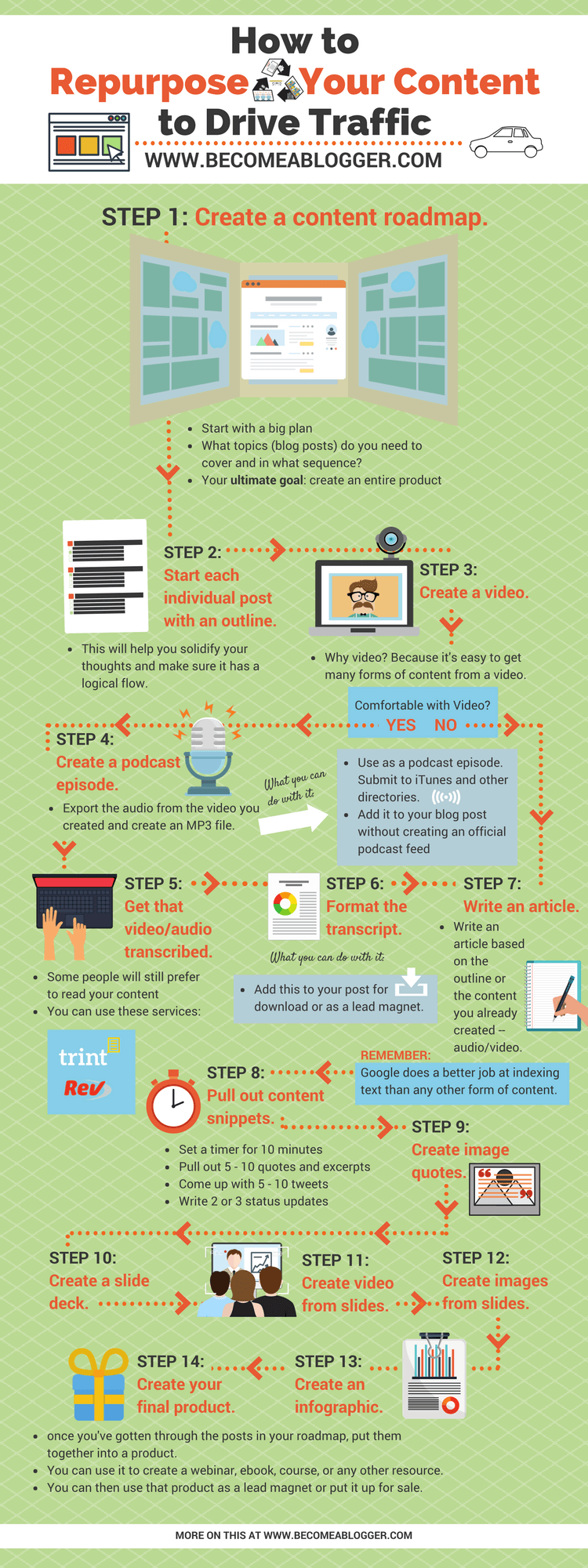
The post How to Repurpose Your Content to Drive Traffic appeared first on Become A Blogger by Leslie Samuel.
from
http://www.becomeablogger.com/24747/repurpose-content/
Tuesday, April 18, 2017
Things look pretty bleak, but I have an idea for you…
Things look pretty bleak…
- 17 out of 18 women make less than $100,000 per year. 1
- In 114 countries, more than half of the adult population is overweight. In America it’s closer to two-thirds. 2
- “Poor at 20, Poor for life.” A new study indicates that from the 1980s to 2000s, people are less likely to move up the income ladder… even with an education. 3
- Loneliness is becoming the next public health epidemic. And even though we are more connected than ever, people are feeling MORE lonely. 4
The odds are stacked against us…
…but I believe we all have the opportunity to, as I call it, Be The Exception.
And while we must continue to fight for what’s right, we must also strive to become one of the people who BEATS the odds.
We must look these statistics in the face and scream “NOT ME!”
We must strive to Be The Exception.
- “17 out of 18 women make less than $100,000 per year? We need to change this. But I will be the 1 out of 18 who makes more. #BeTheException”
- “Two-thirds of people are obese? We need to fight against bad food. But I will be the 1 out of 3 people who lives at a healthy weight. #BeTheException”
- “Born poor? Stay poor? We need to fix our education system. We need to make things fair for everyone. But I will get rich. #BeTheException.”
- “People are lonely? We need to figure out what’s happening. But I will pursue healthy relationships that make me feel fulfilled. #BeTheException.”
I’m Derek Halpern, and I’m the founder of Social Triggers. I’ve always said that I created Social Triggers to help business owners and entrepreneurs get ahead in business and life.
Or, in other words, I created Social Triggers to help people Be The Exception.
You may have seen my short motivational video about just that…
And you may also know that we’ve helped people start their business. We’ve helped people attract remarkable customers. We’ve helped people launch their blog and build highly engaged audiences. We also helped people be more confident.
And we will continue to do that.
But I noticed something interesting…
When I talk to my successful entrepreneur friends, people who live the #BeTheException Life, I noticed that we all focus on several areas of personal growth and development.
As a matter of fact…
I noticed that people who truly #BeTheException focus on 3 Core Pillars of Growth and Development.
#BeTheException Pillar #1: Business (and Career)
People focus on their business and career. After all, more money means more options. Also people like knowing they’re working towards building something bigger than themselves.
#BeTheException Pillar #2: Health (and Fitness)
People focus on their health and fitness. Especially now. We want to make money, pursue our passion, do something amazing, but we need to be healthy. No one wants to be the most successful person who got sent to the cemetery earlier than anticipated.
#BeTheException Pillar #3: Happiness (and Fulfillment)
People find happiness through different ways. We focus on our friendships. We focus on our relationships. We focus on our children. We focus on self-development. And this is equally as important as everything else. Sometimes even more important.
These are the 3 pillars of the #BeTheException life and mindset.
And they are all important.
Now, don’t get me wrong…
I understand how hard it is to focus on these other areas of your life when you’re building your business, but ignoring them can have detrimental effects.
For example, I found out I had a heart condition, got a heart procedure that cured it, and still didn’t take my health seriously.
Fast forward a couple years later and I had high blood pressure and was 30 pounds overweight. Then, last year I made a lifestyle change. I focused on my business (and I launched 3 new products, 2 courses and a software product). I also focused on my health (and lost all that weight I gained).
No matter how bleak the odds…
…we all have the opportunity to #BeTheException.
And I want to help you do it.
Now…
What I want to hear from you is this:
How are you focusing on each of these 3 key pillars of the #BeTheException life right now?
How are you working on:
#BeTheException Pillar #1: Business (and Career)
Are you launching a new product? Are you starting a new business? Are you trying to grow your email list?
#BeTheException Pillar #2: Health (and Fitness)
Are you working on your diet? Are you going to the gym? Are you walking more? Are you trying to stand more often?
#BeTheException Pillar #3: Happiness (and Fulfillment)
Are you investing in your relationships? Are you building a family? Are you making new friends? Are you investing in yourself?
If you’re only focusing on one pillar right now, that’s okay. Share that too. But I’m curious to hear what you are currently working on and how you’re working on it.
Leave a comment.
And share this with someone who needs to hear this message.
And if you’re new here, sign up for the mailing list. You’ll get tons of great stuff just like this.
Sources:
1. http://www.washingtonpost.com/wp-dyn/content/article/2010/10/06/AR2010100607229.html
2. https://www.bloomberg.com/graphics/2016-global-obesity/
3. https://www.theatlantic.com/business/archive/2016/07/social-mobility-america/491240/
4. http://www.independent.co.uk/life-style/health-and-families/features/the-loneliness-epidemic-more-connected-than-ever-but-feeling-more-alone-10143206.html
from
http://feeds.socialtriggers.com/~r/SocialTriggers/~3/wl3n3yHwZ6o/
Thursday, April 13, 2017
Fun fact: If you rely on “word-of-mouth,” you need help
Fun fact: If you rely on “word-of-mouth,” you need help.
Specifically my help.
Here’s why:
Everyone knows the BIG PROBLEM with Word-of-Mouth…
…but no one thinks it will happen to them.
I’ll explain.
Look: Word-of-mouth is a great way to build a business.
It means that your product or service is good enough that people are willing to recommend it.
Good on you. You’re good at what you do.
The problem?
It’s a slow burn. Sometimes you get clients. Sometimes you don’t. And the reality is this: you can’t rely on it.
…Because what if all of the word-of-mouth dries up?
“I lost my biggest referral partner.”
Take Rachael Scott, a clinical massage therapist, as an example. A few years back, she told me “I lost my biggest referral partner who had been referring 30% of my clients. It was a wake up call that I really needed to diversify and find more ways to attract clients to my brick and mortar business.”
“$0 one month. $5000 the next. I hate unpredictable revenue!”
Or how about any freelancer? You know. $0 one month. $5000 the next. That’s how Word-of-Mouth works. It’s choppy and you never know where the next client will come from.
“People keep offering me WAY BELOW what I’m worth and I’m tired of it!
Ever get offered $500 for a $5000 job? Your word-of-mouth clients may not offer you so little. But randoms? They almost always offer ou less and that’s a problem if word-of-mouth dries up, right?
Now, what if I told you that you can break free from the “word-of-mouth” trap.
And what if I said you could reliably, and realistically, generated “customers-on-demand.”
How?
Well…
You Need A Sales Page…
And not just any sales page.
A Sales Page that Converts.
Here’s why:
When you have a Sales Page that Converts, you can test different ways of attracting customers. You can continue to get Word-of-Mouth clients, but you can also try things like social media, blogging, advertising, affiliate marketing, and more.
…because when you have a Sales Page that Converts, you can SEE what works best and do more of it.
However, most people think these other ways of ‘attracting customers’ never works. Why? Because they send them to a “request a quote page” that looks like this:
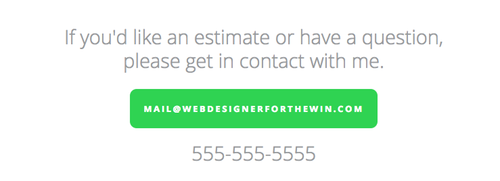
If it’s a word-of-mouth client.
FINE.
No issues here.
But if it’s someone who just stumbled on your site, why would they hire you? You don’t show your value. You don’t explain why you can help. You don’t do anything other than ask them to contact you…
(No wonder people try to under pay you).
However…
When you send these people to a Sales Page that Converts… that’s when the magic happens.
The Truth About Sales Pages In 2017
People think sales pages have to look spammy.
NOT ANYMORE.
The world’s smartest companies use sales pages to persuade people to buy their products and it doesn’t feel scammy or salesy or anything like that.
Take a look:
Big companies use them…

Small businesses who sell online courses, coaching, consulting, and other services use them too:

And if you look around, you’ll see different types of businesses who use sales pages to persuade people to buy.
Personally, I’ve seen people use sales pages to sell anything from an e-book, to a speech, to a hand-made leather bag, to an online course, to a piece of software…
Why do so many smart companies create sales pages?
Well…
A Sales Page that Converts allows you to diversify the way you attract clients. And believe it or not, when done right, a sales page can do a whole lot more.
(Imagine if you sent people to your your product or service page and you started getting offered $10,000 for $5000 job. Imagine sending them to a page and getting the sale RIGHT NOW vs answering one million questions. Would be nice, right?)
A Sales Page that Converts can help you increase your prices (without getting pushback from prospects).
(Imagine if, instead of discounting your product to make the sale, you INCREASE THE PRICE of your product and still sold well).
A Sales Page that Converts can help you attract more customers from different sources (Did you know that there’s a fundamental difference between a sales page that converts “word-of-mouth” prospects vs “cold” prospects?)
(Imagine if you could close more sales from word-of-mouth… from Facebook ads… from email marketing… from affiliate marketing… and more. How would that impact your business?)
A Sales Page that Converts can be used for years. The Wall Street Journal ran one sales page for 28 years. I’ve run one of my sales pages for about 5 years now (aside from minor tweaks here and there).
(Imagine if you never had a spend one more second on selling. Imagine if the sales page did all the work and you focused on delivering a high quality product or service to your paying customers?)
Sounds like a pipe dream?
NOT ANYMORE!
Here’s The Easiest Way To Learn How To Create A Sales Page…
…even if you’re not a writer.
I put together an online course called Sales Page that Converts.
Enrollment is now open, but it closes tomorrow.
Inside this course I show you everything you need to do to make a remarkable sales pages… even if you’re not a writer.
A great sales page can have a drastic impact on your business, and this course can help you make one in the next 30 days.
But don’t take my word for it.
And check this out:
These 3 Business Owners Created A Sales Page that Converts
I could tell you how great this course is, but I rather introduce you to 3 remarkable success stories.
Lisa increased the price of her course from $297 to $497 – a 67% increase. And even though she struggled to sell her course at a cheaper price, she was successfully selling her course for more money… with less headaches.
Ben and Cole launched a “high-end” version of their course (it was 60% higher than their lower priced product). 1 out of 5 customers opted for this more expensive option, and their sales page helped them sell it.
Or take the case of Austin Roberson. He was launching a new monthly membership, and he got 25 people to pay him $299 per month – earning about $7500 in recurring revenue. Again. Because of his sales page.
So…

Learn About Sales Page that Converts Now

“I didn’t know how valuable a sales page was.
This course changed the way I run my launches.”
– Austin Roberson

Derek, your Sales Page That Converts course is,
hands-down, the most helpful online course I’ve ever taken
— and I’ve taken a LOT of them.”
– Beth Hayden
P.S. The bottom line? If you rely on word-of-mouth, you are taking a HUGE risk. Sales Page that Converts can help you diversify how you attract clients.

Learn About Sales Page that Converts Now
from
http://feeds.socialtriggers.com/~r/SocialTriggers/~3/wEx0lK8QK-w/
How to Create Content People Will Still Remember in 5 Years’ Time

What the heck happened?
You had a brilliant idea for your blog.
You spent days (or even weeks!) bringing your idea to life — editing, tweaking, and perfecting every syllable.
You used every promotion strategy and technique in your arsenal to ensure the world would know about your blogging masterpiece.
So when you laid down to sleep that first night, you were certain you had a winner on your hands — the kind of content that could stand the test of time and be spoken of with reverence years later by adoring fans who named their firstborn after you.
But faster than you can say “Keyser Soze,” your content was — poof! — gone.
After its initial wave of popularity subsided, your masterpiece faded into the background as newer and newer content popped up.
Instead of standing the test of time, your content was forgotten.
And the only adoring fan willing to name their firstborn after you was your spouse.
Seriously…
What the heck happened?
The Painful Truth: Most Content Will Disappear Into Obscurity Days after Hitting “Publish”
It’s sad but true.
Most online content, even when it’s excellent, is quickly forgotten.
Sure, it may be popular for a little while. For a few glorious moments, it may be flush with laudatory blog comments, congratulatory emails, and social media love.
But, eventually, its popularity fizzles out.
With two million new blog posts published each and every day, only a select few are able to stick in the minds of readers.
How do these select few do it? How are they so memorable?
More importantly, how can you repeat what they do so your content has a chance to still be remembered years from now?
That’s what this post will teach you.
The 5 Crucial Qualities of Unforgettable Content
If you want to create content that people will remember and reference for years — not just days — after you click publish, you need to give it one (or more) of the five qualities we’re about to discuss.
Ready?
Let’s get started.
Quality #1: Gives Readers an “OMG!” Moment
Remember the end of Se7en when Kevin Spacey’s master plan was revealed?
Remember when your mouth dropped open after Darth Vader made the shocking (and often misquoted) revelation that he was Luke’s father?
Remember how stunned you were at the end of The Sixth Sense when you learned that Bruce Willis’s character had been wearing a toupee the entire time?
These movies caught us off guard, jolted us to attention, and got us talking.
And years later, we’re still talking about them.
Why is that?
They’re quality movies for sure, but there’s more to it.
As Chip and Dan Heath discuss in their book Made to Stick, our brains filter out consistency in favor of focusing on differences.
So instead of remembering by-the-numbers movies that end exactly how we expected, we remember the ones with unexpected twists and surprising revelations.
Those are the stories that stand out, stick in our minds, and get us talking about them.
How does this relate to blogging?
If you want your content to be remembered, try surprising your reader.
It’s a tried-and-true method for crafting content that sticks.
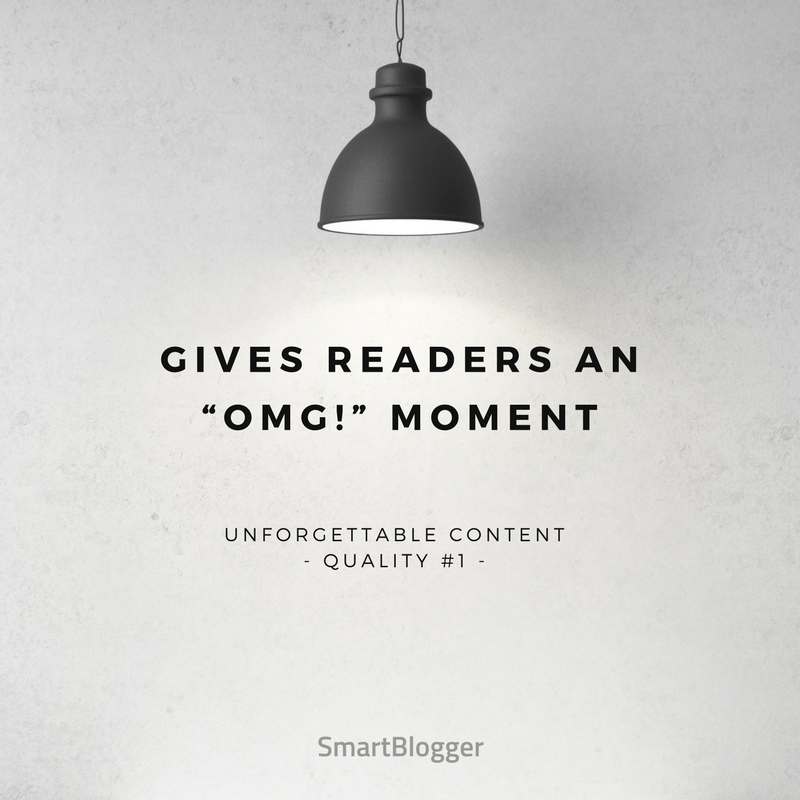
How It’s Done
Have you ever come across a headline that stopped you in your tracks?
Why James Chartrand Wears Women’s Underpants is such a headline. It’s surprising, different, and catches you off guard.
But it’s nothing compared to the surprises inside the post.
The first revelation is that James Chartrand is actually a woman; however, the big discovery is why she took and continues to prominently use the name James Chartrand as her pen name.
She explains how a simple name change was able to take her from a struggling freelancer to a well-known blogger.
While the result was unintentional, she reaped many benefits from taking on a male persona — an easier time getting jobs, more respect for her work, and more recognition.
Undeniably, the post is brilliantly written. That makes it great.
But it’s the surprise factor that makes James’s post so gosh-darn memorable.
How You Can Do It
Creating surprising content is not an easy task, and it requires a well-thought-out idea to achieve it. But here are two ways you can get it done:
#1. Drop a Bombshell
Do you have a secret your readers would find surprising?
You’re a travel blogger who’s never flown on a plane? Do you blog about healthy eating but stuff your face with cake on a weekly basis? Are you a fashion blogger who once wore an orange tuxedo to a charity gala?
Tell your readers. Give them your reasons. Get them talking.
#2. Break the Norm
Let’s be honest… Most tips, advice, and strategies you find online — regardless of the niche — are unoriginal. You’ve seen them before, and so have your readers.
Want to surprise your audience?
Offer them unconventional advice they haven’t heard a thousand times before. Give them a truly new idea or insight. Provide a simpler technique or shortcut that makes them cry over all the time and effort they wasted doing things the regular way.
A surprising revelation doesn’t have to be extraordinary or outlandish for people to remember it.
Sometimes, it just needs to thwart you reader’s expectations.
Tweetable Takeaway
 Want a proven method for crafting content that sticks in your readers’ heads? Surprise them. (Tweet This)
Want a proven method for crafting content that sticks in your readers’ heads? Surprise them. (Tweet This)Quality #2: Overwhelms the Senses (Including Taste Buds)
Remember the final scene in Field of Dreams when Ray Kinsella has a catch with his dad?
You can hear the sound of the baseball hitting their gloves. You can smell the grass on the field. You can feel Ray’s years of guilt melting away as he closes his eyes, smiles, and tosses the ball back to his dad.
(Be honest. You’re crying right now, aren’t you?)
Field of Dreams made you feel like you were in Ray’s shoes, on his field, playing catch with dad. The scene creates such a vivid experience for viewers that whenever they think of playing catch, this scene will come up alongside their own childhood memories.
That’s the power of content that overwhelms your senses.
When you paint a strong scene in your audience’s mind, you make it easier for them to pull it back up from their memory. You’ve essentially bookmarked it for them so they can easily find it when something — a sight, a smell, a sound — reminds them of it.
And the precious few bloggers who can paint such scenes with their writing have been rewarded for their efforts.
Rewarded with tweets. Rewarded with email subscribers.
Rewarded with posts remembered long after their publish dates.

How It’s Done
The trick is to use descriptive language that conveys sensations and lets readers experience what you want them to gain from your writing.
Few writers are better at this than Jon Morrow.
In his post 7 Lessons from a Guy Who Can’t Move Anything But His Face, he uses descriptive storytelling to help the reader get an idea of what it might feel like to be him; specifically, what it’s like to live with a disability.
Had he simply told his readers facts, the points in Jon’s post wouldn’t have resonated with them the same way.
So Jon puts the readers in his shoes. The ups, the downs, and everywhere in between.
And they remember him because of it.
How You Can Do It
If you’ve taken a good English or writing class, you’ve probably been told a time or two to “show, don’t tell.”
This means you want to create an engaging experience for your audience; not just tell them what you want them to know.
But it also means giving your readers specific, concrete advice.
Your reader shouldn’t try in vain to grasp abstract concepts, such as building courage or showing kindness. These are hard to visualize and too vague to put into action.
What would building courage look like? What would showing kindness look like?
Give them concrete actions to take that would display these concepts, like asking someone out on a date (courage) or hugging a stranger (kindness).
You must engage the senses both in the stories you tell and the advice you give, or they will both be quickly forgotten.
Here are a few more specific ways to create engaging, sensory-overloading experiences:
#1. Paint a Mental Picture: What Do You See?
It isn’t enough to tell your readers there was a scary house in your neighborhood when you were a child. Describe the house to them in vivid detail.
What shade of gray was it? Were the doors boarded up? Precisely how many ghostly figures did you see staring at you from the upstairs bedroom windows, and how many are standing behind you right now?
#2. What Do You Hear?
We listen to uptempo songs to push us through cardio workouts. We listen to rainfall when we’re trying to sleep. We listen to Justin Bieber when we want to punish our neighbors.
Want to transplant readers into your world?
Talk about the drip, drip, drip of the faucet. Mention the squeaking floors beneath your feet. Describe the awful music coming from your next-door-neighbor’s house.
#3. What Does it Taste Like?
Does the beach air taste salty? Is the roaring fire so intense you can taste the smoke? Is the smell of your roommate’s tuna fish sandwich so strong you can taste it from across the room?
Tell your audience. Make them taste the fishiness.
Tweetable Takeaway
 Make readers see what you see. Put them in your shoes and take them on an emotional journey. (Tweet This)
Make readers see what you see. Put them in your shoes and take them on an emotional journey. (Tweet This)Quality #3: Coins a Contagious Catchphrase
“The quicker picker upper.”
“The ultimate driving machine.”
“Melts in your mouth, not in your hands.”
Unless you’re one of the precious few whose brains haven’t been inundated with advertisements over the years, you probably recognize these slogans. You also probably recognize the companies that created them.
That’s what a great slogan, phrase, or title can do.
They’re memorable. They differentiate the brand. They often outline a key benefit.
If you want your content to have a chance to stay relevant for years to come, present something that’s novel and — this is key — condense it to its essence.
The end result will be a phrase or idea people will immediately associate with your content.
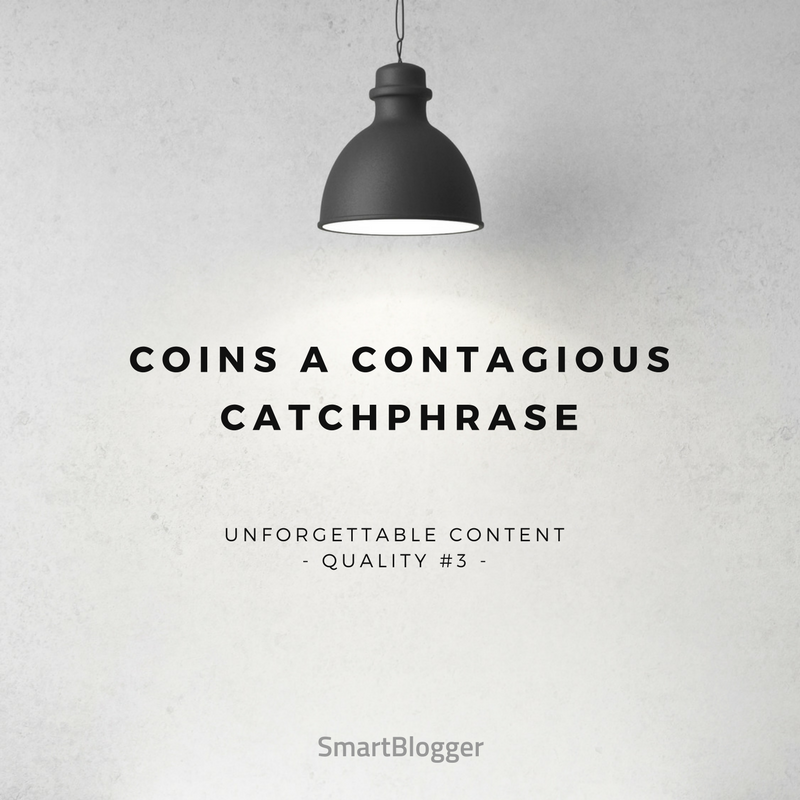
How It’s Done
The post 1,000 True Fans by Kevin Kelly created an idea that was short and sweet: you can make a living doing anything if you have just 1,000 true fans.
He defined this simple, brilliant idea and then spent the rest of his post explaining why it worked and what you had to do to make it work.
Written in 2008, Kevin’s post is still remembered and referenced all these years later.
Why?
Because the phrase “1,000 true fans” condenses its concept into a simple, catchy phrase. And that makes it easier for people to remember and repeat in conversation.
Brian Dean does something similar in his post The Skyscraper Technique, which teaches a useful link-building strategy for beginners and veterans of Search Engine Optimization (SEO) alike.
After naming his technique, Brian breaks it down into easy-to-follow steps so his audience can quickly get what they need from his post.
The technique is fairly simple and its title, again, is quite catchy.
You can grasp the concept of Brian’s idea simply by its name. You can visualize it. You can close your eyes and see it in action.
And that helps make it memorable.
How You Can Do It
Ask yourself a few questions…
What is your post about? Can you boil your main idea down into a memorable phrase or title? Does it present a unique perspective or technique? Does it address a real need or concern many people can connect with?
Your phrase should be simple and leave an impression on your audience, whether that’s giving them an “aha” moment or simply piquing their interest so they’ll be curious to hear what you have to say.
And once you have settled on a memorable phrase or title, feature it prominently. Include it in your headline. Repeat it, as needed, throughout your post.
Tweetable Takeaway
 Create something useful and your audience will read it. Make it catchy, and they’ll remember it. (Tweet This)
Create something useful and your audience will read it. Make it catchy, and they’ll remember it. (Tweet This)Quality #4: Strips You Down and Lays You Bare
If you really want to write a post that resonates with people, you need to connect with them on a deep, personal level. You need to strip your defenses and show your vulnerable side.
This not only sets you apart from all the regular, straight-laced content your audience is exposed to, it helps you relate to them in a way that’s meaningful.
Why do you think Taylor Swift is so popular?
It’s not because she has a better voice than everyone else. It’s not because she’s seven feet tall. It’s not even because she frequently posts pictures of her cat on Twitter and Instagram.
It’s because her lyrics connect with her audience.
From teardrops getting on her guitar to shaking off the fact that haters insist on hating, Taylor often shows vulnerability in her songs.
This vulnerability endears her to her fans. When they look at her, they see a seven-foot-tall version of themselves. They see a kindred spirit.
And you don’t forget kindred spirits very easily.

How It’s Done
Jon is masterful at showing vulnerability.
In his post On Dying, Mothers, and Fighting for Your Ideas, Jon recounts the story of his mother’s tenacity in the face of his condition, which his doctor labels terminal.
He does this beautifully by telling the story first from his mother’s perspective, then from his own, and — lastly — he ties it into his main point: writers have to fight for their ideas with all the determination and love with which mothers fight for their children.
Such an appeal to the audience’s emotions is powerful. It hits home. It’s memorable.
If you want to make your content memorable, make it personal.
How You Can Do It
There are many, many ways you can show vulnerability in your writing. Here are a few ideas:
#1. Open a Window into Your Life
Like Jon does in many of his posts, you can draw your audience in with a personal story.
This works especially well if it exposes you in some way to the reader or helps them relate to you. When you write, you’re asking your audience to trust you with their time and attention.
Show them why they should feel comfortable trusting you.
#2. Reveal Your Intentions
Do you have personal reasons for writing your post?
Be candid with your audience and tell them why the subject means so much to you.
It’s easy for your audience to see you as just another faceless entity trying to sell them a product or idea.
Break this image by showing them your human side.
#3. Expose Your Fears and Anxieties
Are you writing about a problem or worry your audience has?
Do you share and understand their anxieties?
Let your readers know you are (or have been) in the same boat they are and show them how that makes you more qualified to write about it.
Tweetable Takeaway
 Don’t be a superhero. Pull back the curtain and let readers see your struggles. (Tweet This)
Don’t be a superhero. Pull back the curtain and let readers see your struggles. (Tweet This)Quality #5: Breaks Your Reader’s Lenses
We all view the world through lenses.
Some are very specific…
“I’ll vote for whichever candidate lets me have chickens in my backyard.”
However, most lenses are common. They shape our thoughts, passions, and widely-held beliefs on everything from sports to religion.
But what if one of the things you’ve believed all your life was turned on its head?
If you want to write content that people will remember in five years, you can’t just give readers random facts.
You need to hold up a mirror so your readers take cold, hard looks at themselves.
You need to challenge something your readers hold dear.
You need to change their worldview.

How It’s Done
Few concepts are as ingrained into the American way of life as the eight-hour workday.
That’s why Leo Widrich’s The Origin of the 8-Hour Work Day and Why We Should Rethink It, which attempts to debunk the eight-hour day by showing how it wasn’t a well-thought-out or highly-optimized number, is so intriguing.
Leo doesn’t offer the reader a new number as an alternative. Instead, he says what his reader should be concentrating on is focus; specifically, how well they are able to focus on the task at hand regardless of how much time they have to complete it.
Another way to change worldviews is to expose your readers to the reasons why they hold the beliefs they do. A great example of this is the post Taming the Mammoth: Why You Should Stop Caring What Other People Think.
Written by Tim Urban, this humorous piece takes the audience through a history lesson that tells them why they care so much what people think, and then guides them on how to overcome this crippling fear.
We’re constantly trying to overcome fear of rejection and embarrassment, so a post telling us why we (foolishly) fear such things definitely hits home.
How You Can Do It
Challenging people’s views isn’t easy, but here are a few ideas to help you do it.
#1. Demolish Beliefs That Lead Them Astray
Look at the commonly held beliefs of your readers and see if you find any of them to be faulty.
Ask yourself question like:
- “What do my readers believe about X that’s untrue?”
- “What often-repeated tips and strategies in my niche are — how to put this delicately — extremely stupid?”
- “What beliefs keep my readers from achieving X result?”
Once you’ve found something faulty, write about it.
That’s what Derek Halpern did when he tackled the “Content Is King” mantra.
It’s what Dries Cronje did when he told bloggers that posting every day was a silly strategy.
And it’s what Jon did when he shot holes in many of the traffic-building techniques used by beginner bloggers.
Demolishing your readers beliefs in a direct, honest, and non-condescending way is an effective strategy for creating memorable content.
#2. Put Your Readers in Someone Else’s Shoes
A great way to get into your readers’ heads and change their perspective is to present them with a story — whether it’s a real one or a metaphor — and challenge them to ask, “How would I feel if … ?” or “What would I do if … ?”
Just think about your favorite books.
The best are ones where we put ourselves into the shoes of the characters. You’re not reading The Three Musketeers, you are The Three Musketeers.
It’s you who is fighting with swords and having swashbuckling adventures.
And once you’re in their shoes, you can more easily see things from their point of view. Suddenly, you’re not viewing the world through your lens. You’re viewing the world through theirs.
That’s what a great story can do. It draws you in. It flips the “sympathize” switch and turns it to “empathize.” Flip that switch in your reader and it becomes that much easier to flip their perspective.
Tweetable Takeaway
 Want to write something people will remember? Turn a commonly held belief on its head. (Tweet This)
Want to write something people will remember? Turn a commonly held belief on its head. (Tweet This)It’s Time to Craft Everlasting Gobstoppers of Memorable Content
With dreams of fame, fortune, and world domination dancing through their heads, ambitious bloggers pour their hearts and souls into content they hope people will remember forever.
Unfortunately, most bloggers have no clue how to craft content readers will remember after their morning cup of coffee.
But you do.
You now understand the five crucial qualities content needs to be memorable. To be spoken of with reverence years later by adoring fans. To stand the test of time.
The days of being dumbfounded as you watch your latest blogging masterpiece fade into the sunset are over.
Are you ready to create content people will still talk about in five years?
Then what are you waiting for?
Let’s do this thing.
from
https://smartblogger.com/memorable-content/
Wednesday, April 12, 2017
How to Create Content That Drives Traffic to Your Blog
Are you struggling to drive traffic to your blog?
Is your content doing its job and getting you the exposure you're looking for?
In this post, I'm going to share how you can create the right kind of content that drives traffic.
Listen to This Episode
My First Blog
I started my online business on January 18th, 2008. It was the day I stumbled onto something called Freebie Trading.
I used Incentivized Freebie Websites that promised to send you free stuff if you complete offers and referred others.
It actually worked, and in my first year, I grossed approximately $29K.

Back then, I started helping people out in forums.
Back then, forums were still a thing. It was the way I got business.
I was active on a Freebie Trading forum and spent tons of time providing value.
When people asked questions, I was there to answer and be helpful.
As a result, MANY of the freebie traders in the forums listened to what I had to say.
I was helping them solve a problem. They wanted to make money, and I helped them do that.
In September of that year, I stumbled onto blogging. I was so excited about it that I started my first blog – The Freebie Guy.
And from that blog, I made consistent content. Content to help freebie traders make money with freebies.
I already had an audience from the forums. My traffic was almost instantaneous.
But it wasn't accidental.
What causes traffic?
There are some things that you have to have right to get traffic to your blog. They are all very specific.
You need to have a:
- Specific audience you are trying to target. My audience was freebie traders.
- Specific problem you're helping your audience to solve. My audience wanted to make money.
- Specific content that you're creating consistently. I created content on how to make money with freebies.
- Specific marketing channels. I used the freebie trading forum that I was active in to let freebie traders know about my new blog.
- Specific actions for them to take. I wanted my audience to find my content so useful that they shared it with their friends.
If any of these components are missing, you will not get the traffic you want to get.
The Psychology of Sharing
To understand what kind of content you should create, let's look at an interesting study.
The New York Times Customer Insight Group did an extensive study on why people share online.

The Psychology of Sharing
Here are the reasons they found:
- To bring valuable, enlightening and entertaining content into the lives of people they care about. Improve the lives of others.
- To define themselves. This is what I stand for/believe in.
- To grow and nourish their relationships. Keeps people connected to each other.
- Self-fulfillment – Satisfaction of sharing. Makes them feel valuable.
- To get the word out about causes they believe in.
- To get increasing amounts of traffic to your blog, you will want people to share your content.
Does your content do any of the above-mentioned points? If not, it's time to rethink your content.
Before you create
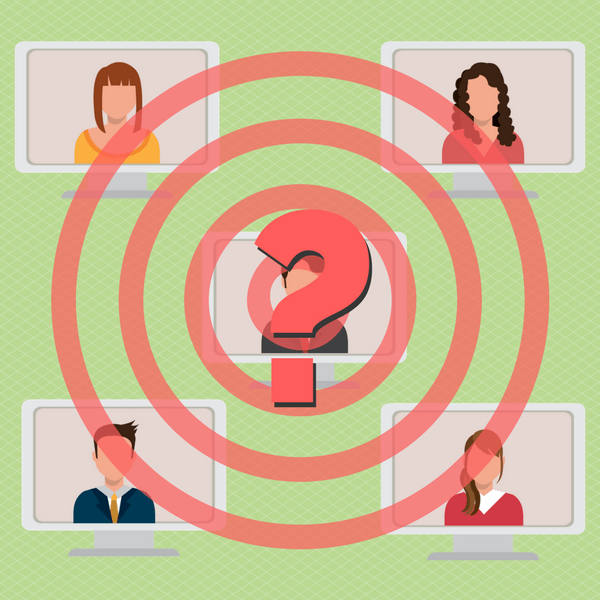
Know who your target customer is
Before you start creating your content, it's important to know who you're targeting.
Sit down and write out who your ideal target person is. Some people call this your customer avatar.
In my case, my avatar is Christina Simmons. Listen to the episode for a detailed description and tips on how to come up with yours.
Creating your content
When it comes to traffic, your content is the most important factor.
A study done by The Aberdeen group showed that the annual growth in unique site traffic is 7.8 times higher for content marketing leaders than followers.
This is not something that you should take lightly. You HAVE TO start with great content, and then improve from there.
In your content, make Christina (insert your avatar's name here) the hero. How?
By using the points found by the study on the Psychology of sharing.
For example…

Does your content give your customers a feeling of self-fulfillment?
How can your content give Christina a feeling of self-fulfillment when they share it?
How can your content help Christina define themselves to others?
THAT'S the kind of content you should be creating.
Taking those principles into consideration, start the brainstorming process.
- Sit down and make a list of 30 – 50 topics by doing the following:
- Answer this question – What questions is she asking?
- Put them in a logical sequence
- Start writing.
For every piece of content, think about what's in it for Christina? What will she feel while reading/consuming?
Make your content EASY to consume
The easier your content is to consume, the more likely she will be to consume it.
Here are a few tips to help you simplify your content and make it more effective.
Have a clear, catchy headline.
Here's a fact that most bloggers don't like to hear.
Eight out of ten people will ONLY read your headline. That kinda sucks.
But it doesn't have to be that way. Spend a significant amount of time on your headline to try to make it as effective as possible.
Have an effective intro paragraph.
Your first paragraph is your most important paragraph. It's what gets Christina to keep reading.
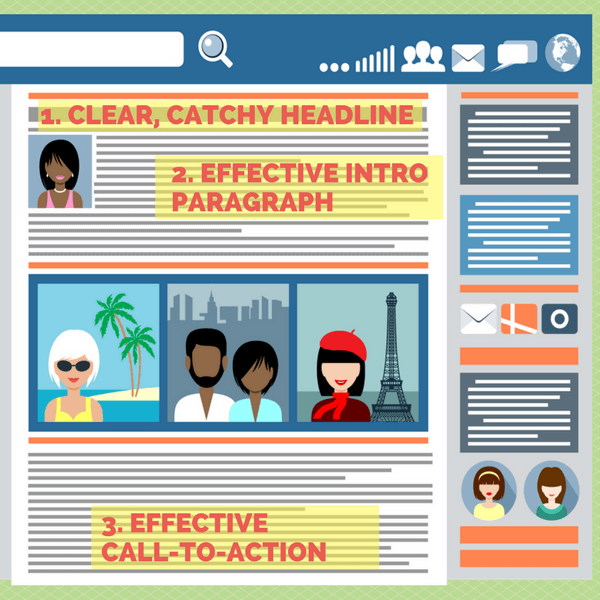
Make your content easy to consume
Your first sentence is the most important sentence. It's what gets her to read the first paragraph.
Here are three tips to help you start off on the right foot:
- Start with a series of questions that illustrates the problem.
- End with a statement on the value she will get by reading your post.
- Or start with an interesting story that illustrates the point of the post.
Deliver on your promises.
The main content of your post should deliver on the promise made by the headline and intro paragraph.
This is where you provide value. Also, keep in mind that the purpose of each sentence is to get her to the next sentence.
Here are some tips for structuring your content:
- Break up your content. Use short sentences and paragraphs. Your paragraphs should not exceed 2 or 3 sentences.
- Use headings to highlight the different sections of your post. This also makes it scannable.
- Use bullet points where applicable
Have an effective call-to-action.
No post is complete without a call-to-action. It's not all about what you have to say.
Always invite them to take part in the experience. Here are some calls-to-action you can consider using:
- Leave a specific comment. You can do this by asking a specific question and asking them to weigh in.
- Share it with your friends on social media. Sometimes people won't share unless you ask. Ask and ye shall receive.
- Check out another related post. They've already demonstrated that they are interested in the topic. Give them more.
- Get a free resource by joining your email list. This is ALWAYS a good idea. Have something related to your content and use that as a list building opportunity.
- Buy a product/service. The fact that they made it to the end of your post says that they are very interested in that topic. If you have a product/service related to that topic, this may be a good time to pitch it.
- Whatever else you can think of. The sky's the limit here, so be creative.
Take advantage of what's trending/happening now
One of the best ways to establish yourself as an expert is to be relevant.

Make sure you are current and relevant.
There's always something new happening in your industry and by sharing that in a timely way, you'd be surprised at what can happen.
To do this, you have to make sure that you are current and informed.
Read your industry publications and follow the news as it pertains to your industry.
Use newsjacking when appropriate. If there's something big in the news, cover it on your blog and share the word.
Sharing hot topics is a great way to drive traffic. But make sure to only do this in a way that provides value.
Consider a video-first strategy
There's one thing that's abundantly clear about where the industry going.
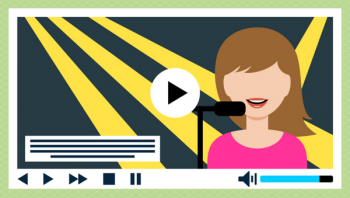
Video strategy
Early last year, Mark Zuckerberg said in an interview with Buzzfeed that he “wouldn’t be surprised if you fast-forward five years and most of the content that people see on Facebook and are sharing on a day-to-day basis is video.”
Later that year, Nicola Mendelsohn, who heads up Facebook’s operations in Europe, the Middle East and Africa said in five years time Facebook “will be definitely mobile, it will be probably all video”.
Facebook and YouTube are in an arms race to dominate the online video space.
This is the time for us bloggers to pay attention and consider going all in on video.
IF you go the direction of video first, the same principles apply.
Also, still have written content along with the video for SEO purposes. Google understands the written word better than anything else.
Repurpose your content for greatest effect
One of the best ways to get more exposure for your content is by repurposing it.
Whenever you create content, convert it into other formats. Then, you can use it in multiple ways on multiple platforms.
This brings more exposure. In fact, it's such a powerful strategy that I will be going into depth on this in next week's podcast episode.
My question for you: How will you change your content strategy over the next few months?
Infographic

[INFOGRAPHIC] How to Create Content That Drives Traffic to Your Blog
The post How to Create Content That Drives Traffic to Your Blog appeared first on Become A Blogger by Leslie Samuel.
from
http://www.becomeablogger.com/24655/create-content-drives-traffic/